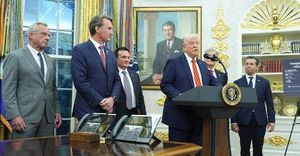The Supreme Court of the United States has propelled the nation into a new era of debate over presidential power, issuing a pair of high-stakes decisions and announcements that could have sweeping effects on the balance of authority in Washington. In a move that has already sparked fierce reactions from across the political spectrum, the Court on September 29, 2025, cleared the way for President Donald Trump to halt $4 billion in foreign aid, while simultaneously revealing plans to revisit a foundational precedent limiting presidential authority over federal agencies.
The first order, handed down just before the end of the federal government’s fiscal year, allowed the Trump administration to freeze billions in foreign aid that Congress had earmarked for global health and HIV initiatives. According to Knewz, the Supreme Court’s conservative majority paused a lower court ruling that would have required the government to distribute the funds by September 30, extending an administrative stay previously put in place by Chief Justice John Roberts.
The Trump administration argued that enforcing the lower court’s order would negatively impact its “conduct of foreign affairs,” a claim the Supreme Court found compelling enough to outweigh the potential harm to nonprofit organizations seeking those resources. The unsigned order, however, stopped short of a final determination, stating, “The relief granted by the court today reflects our preliminary view, consistent with the standards for interim relief.”
Three liberal justices—Elena Kagan, Sonia Sotomayor, and Ketanji Brown Jackson—dissented, voicing alarm over the majority’s willingness to allow the executive branch to override Congress’s spending decisions. Justice Kagan, in a sharply worded opinion, emphasized, “The Constitution gives Congress the power to make spending decisions through the enactment of appropriations laws. If those laws require obligation of the money, and if Congress has not by rescission or other action relieved the executive of that duty, then the executive must comply.” She added pointedly, “It cannot be heard to complain, as it does here, that the laws clash with the president’s differing view of ‘American values’ and ‘American interests.’”
Kagan also criticized the Court’s increasing reliance on its emergency docket for cases of such significance, noting, “We have had to consider this application on a short fuse—less than three weeks. We have done so with scant briefing, no oral argument, and no opportunity to deliberate in conference. When we begin the court’s new term in October, we will decide cases of far less import with far more process and reflection.”
This latest development is just the latest chapter in President Trump’s months-long effort to reshape U.S. foreign policy spending. Since January 2025, the administration has been working on two fronts: defending the president’s authority to cut foreign aid in federal court, and simultaneously urging Congress to rescind the funds it had already allocated. On January 30, Trump signed an executive order declaring that “no further United States foreign assistance shall be disbursed in a manner that is not fully aligned with the foreign policy of the president of the United States.” Following that directive, Secretary of State Marco Rubio halted all foreign aid distributed through both the State Department and the U.S. Agency for International Development (USAID), pending a comprehensive review to ensure all programs fit within the so-called America First agenda.
While the Supreme Court’s order was careful to note its preliminary nature, legal scholars and policymakers alike are already speculating about its broader implications. The decision, some argue, could set a precedent making it easier for presidents—now and in the future—to block or redirect congressional spending without explicit legislative approval. For supporters of a strong executive branch, this marks a welcome shift; for critics, it represents a dangerous erosion of checks and balances.
But the Supreme Court isn’t stopping there. In a separate but related move, the justices announced they will reconsider Humphrey’s Executor v. United States, a 1935 decision that has long limited the president’s power to remove certain executive branch officials. According to BizPac Review, this case has come under renewed scrutiny after President Trump fired Rebecca Slaughter, a former Federal Trade Commission (FTC) employee appointed by President Joe Biden. The Court ruled 6-3 that Slaughter could remain in her position while the justices revisit whether the old precedent should still stand.
Hans von Spakovsky, a legal fellow at the Heritage Foundation, told Fox News Digital, “The Constitution says the president is the head of the executive branch. That means, just like the CEO of a big corporation, they get to supervise and run the entire corporation, or in this case, the entire executive branch, and you can’t have Congress taking parts of that away from him and saying, ‘Well, they’re going to keep doing executive branch things, including law enforcement, but you won’t have any control over them.’”
South Texas College of Law professor Joshua Blackman weighed in, predicting, “I think this ruling will necessarily reach beyond the FTC. The only question is whether they maintain that the Federal Reserve is different.”
Legal observers note that the Supreme Court has been inching toward this moment for years. As reported by Fox News, the Court’s 2010 decision narrowing the Sarbanes-Oxley Act by stripping independence from an accounting oversight board, and its 2020 ruling that the president could fire the Consumer Financial Protection Bureau director at will, both hinted at a growing willingness to expand presidential removal power. Chief Justice Roberts wrote in the latter case that the president’s ability “to remove—and thus supervise—those who wield executive power on his behalf follows from the text of Article II.”
Boston University School of Law professor Jed Shugerman offered a nuanced take, saying online that Trump “has done more to establish a unitary executive than all the judges and legal scholars in the world could ever do,” but also contending that Trump “has done more to discredit and expose the unitary executive theory as lawless authoritarianism than any judge or legal scholar could ever do.”
If the Supreme Court ultimately overturns Humphrey’s Executor, the consequences could be profound. Such a decision would not only allow Trump—and any president after him—to exercise sole control over the executive branch, but it could also fundamentally alter the relationship between Congress and the presidency, reshaping the structure of American government for decades to come.
As the Supreme Court prepares to open its new term in October, the nation is bracing for a set of rulings that could redefine the boundaries of presidential power, congressional authority, and the future of federal agencies. For now, the only certainty is that the debate over the limits of executive authority is far from over—and the stakes have never been higher.



